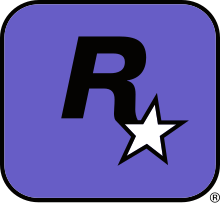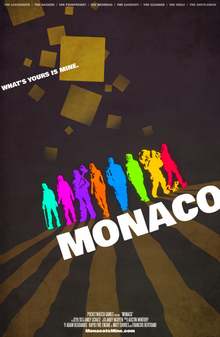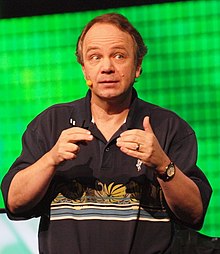Portal:Video games
The Video Games Portal

A video game, also known as a computer game or just a game, is an electronic game that involves interaction with a user interface or input device (such as a joystick, controller, keyboard, or motion sensing device) to generate visual feedback from a display device, most commonly shown in a video format on a television set, computer monitor, flat-panel display or touchscreen on handheld devices, or a virtual reality headset. Most modern video games are audiovisual, with audio complement delivered through speakers or headphones, and sometimes also with other types of sensory feedback (e.g., haptic technology that provides tactile sensations). Some video games also allow microphone and webcam inputs for in-game chatting and livestreaming.
Video games are typically categorized according to their hardware platform, which traditionally includes arcade video games, console games, and computer (PC) games; the latter also encompasses LAN games, online games, and browser games. More recently, the video game industry has expanded onto mobile gaming through mobile devices (such as smartphones and tablet computers), virtual and augmented reality systems, and remote cloud gaming. Video games are also classified into a wide range of genres based on their style of gameplay and target audience. (Full article...)
Featured articles –

Rockstar San Diego, Inc. (formerly Angel Studios, Inc.) is an American video game developer and a studio of Rockstar Games based in Carlsbad, California. The studio is best known for developing the Midnight Club and Red Dead series.
The Colombian entrepreneur Diego Angel founded the company as Angel Studios in January 1984 after studying film in Chicago, where he had grown fond of computer animation. The studio began with a focus on animation and visual effects for multimedia productions, such as advertisements, films, and music videos. Notable works include the film The Lawnmower Man and the music video for Peter Gabriel's song "Kiss That Frog". Angel Studios began working in the video game industry during the 1990s, creating cutscenes for Ed Annunziata's Ecco: The Tides of Time (1994) and Mr. Bones (1996). The company fully developed games with Nintendo (Major League Baseball Featuring Ken Griffey Jr. and Ken Griffey Jr.'s Slugfest) and Microsoft (Midtown Madness and Midtown Madness 2), and it produced a port of Capcom's Resident Evil 2 for the Nintendo 64.
Rockstar Games was impressed with the studio's work on Midtown Madness and offered a long-term partnership in 1999, which resulted in the creation of the Midnight Club and Smuggler's Run series. The publisher's parent company, Take-Two Interactive, acquired Angel Studios in November 2002 and integrated it with Rockstar Games as Rockstar San Diego. Angel left the studio in May 2005 and returned to Colombia. Since 2004, Rockstar San Diego has operated an internal game engine team that develops Rockstar Games's proprietary Rockstar Advanced Game Engine, which is used in most of the publisher's titles. The studio led the development of further Midnight Club games, Red Dead Revolver (2004), Red Dead Redemption (2010), and its expansion pack Undead Nightmare. It collaborated with other Rockstar Games studios on Max Payne 3 (2012), Grand Theft Auto V (2013), and Red Dead Redemption 2 (2018). (Full article...)
Presented in a first-person perspective, the game follows a robotic rabbit named "Robbit" as he searches for missing jet pods scattered by the game's astrophysicist antagonist character Baron Aloha. Robbit must explore each section of Crater Planet to retrieve all of the jet pods, stop Aloha and save the world from being destroyed. The game was designed as a technology demonstrator for the PlayStation console and was revealed in early 1994 under the provisional title of "Spring Man". Jumping Flash! utilizes much of the game engine used in Geograph Seal, an earlier game by Exact for the Sharp X68000 home computer.
Jumping Flash! has been described as an ancestor of, as well as an early showcase for, 3D graphics in console gaming. It was generally well received by critics, who praised its graphics and unique 3D platforming gameplay, but it was eventually overshadowed by later 3D platformers of the fifth console generation. Jumping Flash! spawned two sequels: Jumping Flash! 2 and Robbit Mon Dieu. It received positive reviews at the time of release, and made an appearance in Next Generation's "Top 100 Games of All Time" just one year after. The game was described as the third-most underrated video game of all time by Matt Casamassina of IGN in 2007. It holds the Guinness World Record as the "first platform video game in true 3D". (Full article...)
The game features a guitar-shaped controller (resembling a miniature Gibson SG) that the player uses to simulate playing rock music. The gameplay is similar to GuitarFreaks, in that the player presses buttons on the guitar controller in time with musical notes that scroll on the game screen. The game features covers of 30 popular rock songs spanning five decades of rock, from the 1960s up through 2005, in addition to bonus tracks. Guitar Hero became a surprise hit, earning critical acclaim and winning many awards from major video game publications, and is considered one of the most influential games of its decade. The game's success launched the Guitar Hero franchise, which has earned more than $2 billion in sales, spawning several sequels, expansions, and other game-related products. (Full article...)
Rare was a prominent second-party developer for Nintendo in the 1990s, and their Killer Instinct series was produced as an exclusive partnership in response to the popularity of Mortal Kombat. Following the success of the 1995 Killer Instinct port for the Super Nintendo Entertainment System, Rare began a sequel for the same platform but transitioned development to its successor, the Nintendo 64, upon its unveiling. Gold was scheduled as a launch title for the new console but was delayed until its North American release in November 1996. It was released in other regions in May 1997. Gold was later included in Rare's 2015 Xbox One retrospective compilation, Rare Replay.
Reviewers preferred the Nintendo 64 port over the arcade release, and appreciated its audiovisual enhancements, but felt that its graphical upgrades and memorization-based combo gameplay were insufficient when compared to fighting games like Tekken 2 and Virtua Fighter 2. Critics recommended Gold primarily for fans of the series and genre, but IGN reported that even fans were upset by changes in the combo system and the absence of several well-liked characters. Gold ultimately did not replicate the success of its Super NES predecessor, and the series remained dormant through its 2002 acquisition by Microsoft until its 2013 reboot. (Full article...)
Monaco: What's Yours Is Mine is a 2013 stealth video game developed by Pocketwatch Games in which players, alone or cooperatively, perform heists and robberies. Players choose from eight characters, each of whom has a unique and beneficial skill, such as the ability to change appearance or tunnel through walls. Monaco's single-player story is told in four acts from perspectives of different characters. The cooperative mode lets up to four players play together in different locations.
Lead developer Andy Schatz began developing Monaco while working for TKO Software. He later founded his independent company Pocketwatch, where he continued development and planned to release it as an Xbox Live Indie Game. While looking for playtesters, Schatz met Andy Nguyen, who became a level designer, producer, and promoter for Monaco. Pocketwatch Games released the game in 2013 for Windows, OS X, and Linux. Majesco Entertainment handled its Xbox 360 release after Microsoft Game Studios twice rejected the game. A Nintendo Switch version, Monaco: Complete Edition, was released in 2019 by Humble Games.
Monaco received positive reviews and won two awards at the 2010 Independent Games Festival. Critics praised its cooperative modes but considered its single-player gameplay inferior for lacking content. Frequently compared to heist films, reviewers praised Monaco's art style and how its minimalist design suited its gameplay. Austin Wintory's soundtrack also received praise. Pocketwatch announced a sequel, Monaco 2, in March 2022. (Full article...)
Doom was announced as Doom 4 in 2008, and that version underwent an extensive development cycle with different builds and designs before the game was restarted in 2011 and re-revealed as simply Doom in 2014. It was tested by customers who pre-ordered the 2014 MachineGames game Wolfenstein: The New Order and the general public. Mick Gordon composed the music, with contributions by Richard Devine. The game also has an online multiplayer component and a level editor known as "SnapMap", co-developed with Certain Affinity and Escalation Studios respectively.
Doom was well received by critics and players. The single-player campaign, graphics, soundtrack, and gameplay received considerable praise, whereas the multiplayer mode drew significant criticism. It was the second best-selling video game in North America and the United Kingdom in the week of its release and sold over 500,000 copies for PCs by the end of May 2016. A sequel, Doom Eternal, was released in March 2020. A prequel, Doom: The Dark Ages, is set to be released in 2025. (Full article...)
The game follows the Simpson family and their friend Apu Nahasapeemapetilon as they witness many strange incidents that occur in Springfield; security cameras, mysterious vans, crop circles, and a "new and improved" flavor of the popular soft drink Buzz Cola that causes insanity. Taking matters into their own hands, they discover numerous shocking secrets, and soon realize these incidents are part of a larger alien conspiracy, caused by Kang and Kodos. The gameplay largely focuses on exploration and missions; players often race enemies and interact with supporting characters on timed quests. The game also features many elements found in role-playing games, such as explorable worlds and side tasks.
Development of The Simpsons: Hit & Run began in late 2001 as a spiritual successor to Radical Entertainment's previous game The Simpsons: Road Rage. Production was extensive, as the team sought to differentiate the game from Road Rage, deeming that their new entry in the franchise required a different direction. The game was heavily inspired by the Grand Theft Auto series, and the development team re-purposed the open-world design and nuanced character development for the game. This encouraged collaboration with the show's writers and cast, who helped to craft the story and dialogue. It was released in September 2003 for the GameCube, PlayStation 2, and Xbox. It was then ported to Windows two months later. (Full article...)
Did you know... -
- ... that a pink skin for Mercy in the video game Overwatch helped raise more than $12 million for breast cancer research?
- ... that Elena from the video game series Street Fighter uses a capoeira fighting style, for which the development team used travel videos as reference material as they had no experience with the style?
- ... that Kainé from the video game series Nier was created in response to a female staff member's vague wish for a "male heroine"?
- ... that when Kaz Ayabe pitched his video game Boku no Natsuyasumi to Sony, he said that illustrator Mineko Ueda was interested in the project even though they had never actually met?
- ... that MicroProse was formed to publish Hellcat Ace after Sid Meier boasted that he could design a better video game than Red Baron in a week?
- ... that the 1999 video game Interplay Sports Baseball Edition 2000 used a public-address announcer while its rivals were switching to two commentators as featured on real MLB game broadcasts?
- ... that the world's largest video game studio is headquartered in a former textile factory?
- ... that a version of the video game Rhino Rumble was not released due to the creators not wanting to add licensed characters?
- ... that for at least 90 minutes, Mori Calliope livestreamed herself begging video game developer Atlus to allow her to stream their game Persona 3?
- ... that before Sarah Elmaleh voiced the player character in the video game Anthem, developed by BioWare, she voiced characters in a mod of an earlier BioWare game?
- ... that the concept of adding strippers to the extreme sports video game BMX XXX was initially proposed in jest?
- ... that the Chicago Sun-Times credits JumpStart Toddlers as the first video game targeted towards babies?
Selected biography –
Selected image -
Recent video game-related events
- September 12, 2024 – 2023–2024 video game industry layoffs
- Microsoft announces that it will lay off 650 Microsoft Gaming employees as part of cuts to its workforce. (Variety)
- August 15, 2024 –
- American video game magazine Game Informer discontinues publication after 33 years. The magazine's website is also shut down. (BBC News)
- May 24, 2024 – Uvalde school shooting
- Families in Uvalde, Texas, U.S., file a lawsuit against Daniel Defense and Activision Blizzard for creating the DDM4 V7 gun and promoting the weapon through the game Call of Duty, respectively. They also sue Meta Platforms for owning Instagram, which was used by the gunman. (AP)
Topics
Categories
Things you can do
In other Wikimedia projects
The following Wikimedia Foundation sister projects provide more on this subject:
-
Commons
Free media repository -
Wikibooks
Free textbooks and manuals -
Wikidata
Free knowledge base -
Wikinews
Free-content news -
Wikiquote
Collection of quotations -
Wikisource
Free-content library -
Wikiversity
Free learning tools -
Wiktionary
Dictionary and thesaurus














































